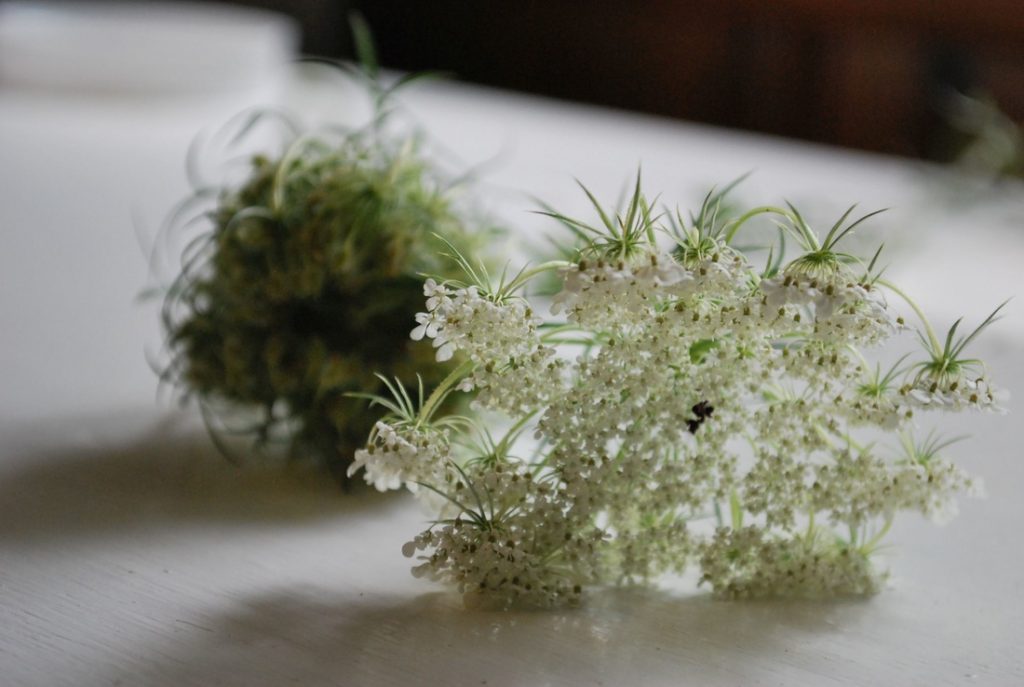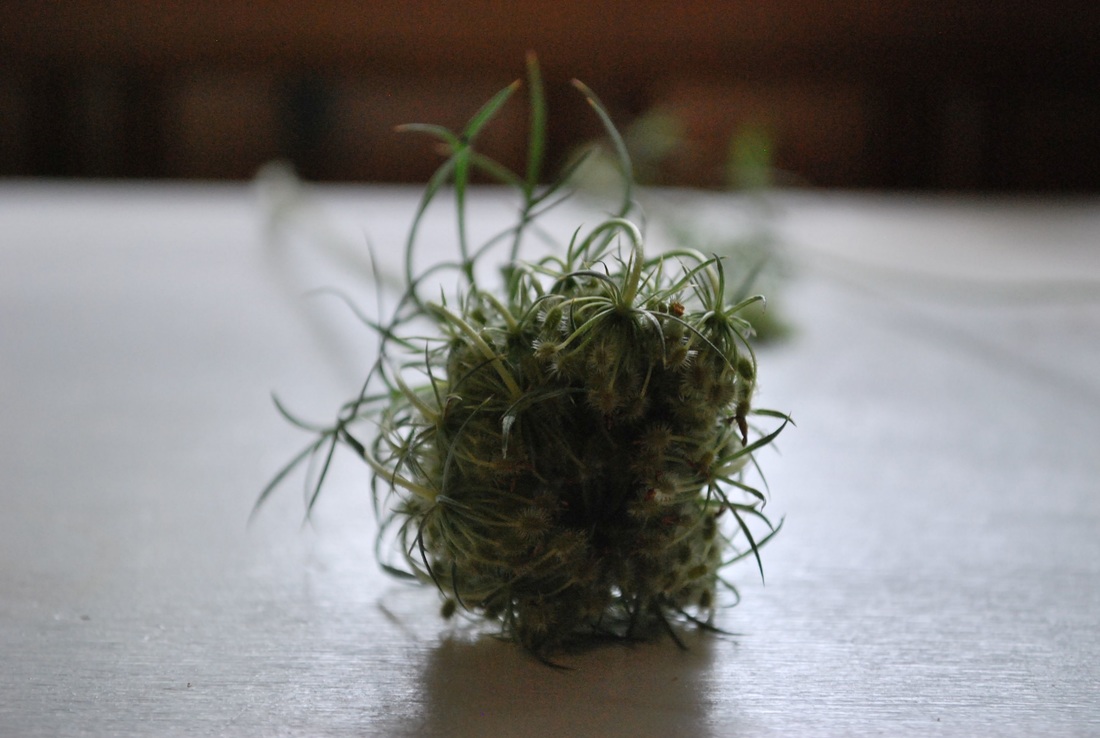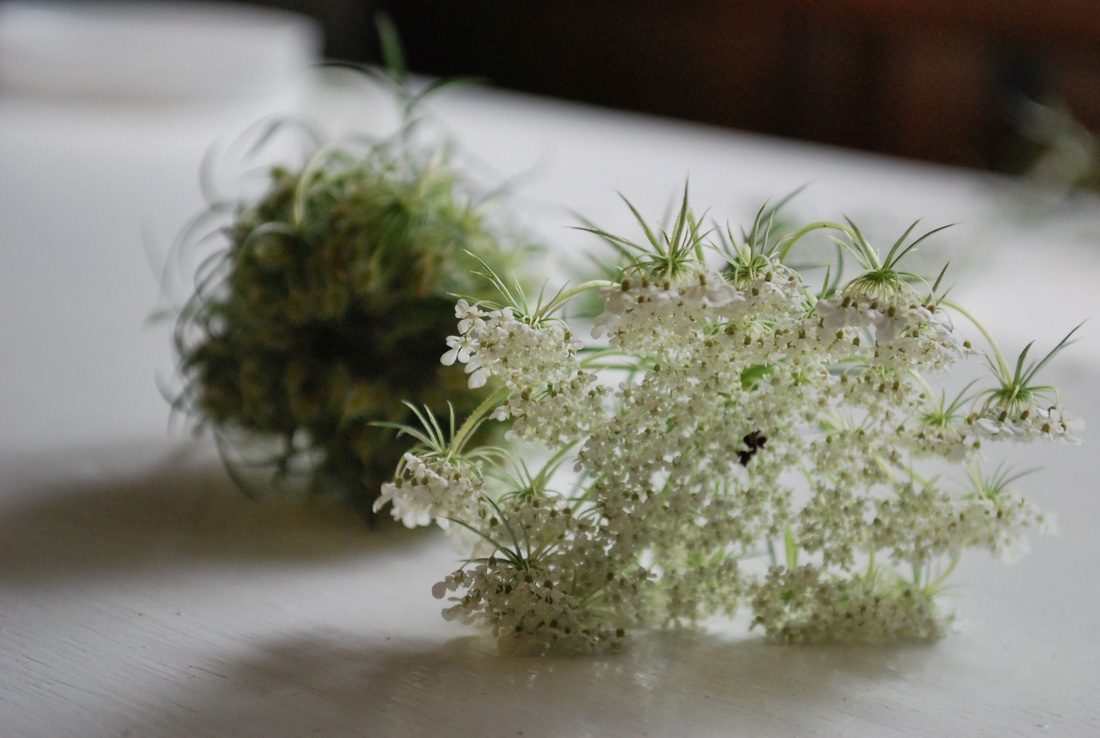Links contained in this post and elsewhere on my website may include affiliate links. When you make a purchase through these links, I earn a commission at no additional cost to you. I only link to products and services that I love - and that I think you will love, too!

Wild carrot, Daucus carota, is a very common weed in my part of the world. It’s also known as Queen Anne’s Lace. Surprise, surprise, it’s not native, and comes from Europe originally. Actually, I was surprised, although I’m not really sure why. I knew that quite a few of the other “southern” weeds come from elsewhere. Maybe it’s because this one seems so un-exotic compared to mimosa and honeysuckle.
Modern sources on wild carrot
Another surprise was that only one of my herbal books had anything to say about Queen Anne’s lace. Matthew Wood’s book, The Book of Herbal Wisdom, has a brief chapter on this plant. It’s much more common in older literature, and I found useful references in King’s American Dispensatory, Scudder’s American Eclectic Materia Medica and Cook’s The Physiomedical Dispensatory. Grieve’s A Modern Herbal echoes most of what is found in the other older sources, although she was writing in the 1930’s rather than the late 1800s, so her language is much more direct and uncomplicated.
Modern herbalists seem to prefer the immature seeds and the flowering tops before they have gone to seed, and occasionally use the roots. I found only one instance of the leaves being used, which was in A Modern Herbal, and mentioned that the leaves could be combined with honey and applied to weeping sores. The seeds are by far the most common portion of the plant used, both historically and presently. In my experience, I favor the immature seeds, when they are still mostly green but the seed head is forming into the signature “nest” and they are beginning to yellow on their way to brown.
Using the seeds of wild carrot
The seeds have three main classifications of use: as a carminative, as a diuretic, and as a rather complex women’s herb. Infusions and extracts seem to be the preferred methods of preparation. Preparation and common use ranges from a teaspoon of seed in a cup of water just brought off the boil, to an ounce of seed per pint of water consumed over the course of the day. Chewing the seeds or adding ground seeds to honey or nut butter has been used as well, if you don’t mind chewing seeds. The seeds feel prickly and stubbly when they are dried, so I personally haven’t tried it.

Wild carrot and the kidneys and bladder
Herbalist John M. Scudder writes about wild carrot in The American Eclectic Materia Medica and Therapeutics (1898). He comments on the seeds:
“The seeds are diuretic, stimulant, aromatic and carminative, and are used in nephritic diseases, gravel, irritution and inflammation of the bladder and urethra, suppression of urine, dysuria from blisters and other causes, gonorrhoea, dropsy, etc.”
Matthew Wood confirms modern herbalists’ experience with wild carrot as a carminative, diuretic, and as an aid in removing sediments in the bladder and kidneys. Because of this influence it can be useful to restore the body’s balance in cases of kidney stones, gout and rheumatism.
He also relates that women have used the seeds to regulate the menstrual cycle. The main influences appear to be an ability to regulate heavy flow, curb the excessive growth of the uterine membrane, and aid against clotting. And yet, here is where the full complexity of this plant as a women’s herb comes to light. It seems to have a toning influence on the uterine lining. However, some women have used the herb in natural family planning.
Wild carrot and fertility
In fact, herbalist Robin Rose Bennett has worked extensively with this herb and even organized a small study. She has an article on using this plant as a women’s herb here. She includes information on the most common ways to take wild carrot for natural family planning and outlines how it was used by the women in the study.
There is also an analysis of pregnancies that occurred during the study. Whether or not wild carrot was being used as suggested in those instances is hard to say. I don’t think there’s really enough information available to make an informed choice about using wild carrot in that way. However, this is probably the main source when you hear information about wild carrot and fertility being passed around in folk circles.
Wild carrot roots
That sums up the seeds, but what about the roots? Cook has the most to say about the roots:
“The boiled roots also act on the kidneys; and form an excellent emollient and gently stimulating poultice in irritable ulcers of all grades. But the fresh and unboiled roots, finely grated, make a peculiar stimulating application of great value. They are excellent in all low forms of sores; such as carbuncles, degenerate abscesses, and buboes; and all fetid ulcers of the malignant, cachectic, and scrofulous grades.”

So, according to him, boiled roots are a diuretic. They also are a softening (emollient) poultice on skin ulcerations when applied topically. Scudder mentions that the boiled roots make a good poultice for burns and “inflamed surfaces”. But the fresh, grated roots seem to make a better topical application as far as Cook is concerned:
“ They correct the fetor, relieve the aching, and quickly promote sound granulation. It is said that they will even abate the suffering of phagedaena and of cancer. They certainly deserve far more attention than they have received from the profession; and sores in which it seems impossible to arouse a healing process by ordinary means, will usually improve at once under this application. The raw carrots are not to be continued after full vital action in the part has been established.”
As usual, some translation is useful when dealing with older herbal texts. “Phageadaena” is a type of rapidly spreading ulcer. By “fetor” Cook means a foul odor emanating from a wound or sore, and “granulation” is the step in healing when the body begins the process of filling in the sore with new tissue.
Harvesting wild carrot
Not bad for another USDA “noxious weed”. If you choose to harvest your own wild carrot, be sure to use a reliable field guide to help you identify. Considering that wild carrot can easily be confused with poison hemlock, accurate identification is not something to take lightly. Some points to check for are the red flower in the center, the correct leaf shape, and the hairy stems.
Wild carrot loves to grow along roadsides. This is not an ideal place to harvest from no matter how healthy the plants seem. They may be contaminated by chemicals and heavy metals leaking into the soil.
If you grow it in your garden instead of wild harvesting, beware that it hybridizes with domestic carrot varieties. This might influence the properties of the wild carrot seed. It will also interfere with heirloom carrot seed-saving plans unless you grow one or the other in isolation.
Identifying wild carrot
The flowers of wild carrot are easily confused with several other herbs and poisonous plants that bloom at the same time of year. See pictures of some of these plants side by side in this article.
Wild carrot can also be used for food and as a seasoning. Because of its beauty it is also popular in floral arrangements and bridal bouquets. With so many potential uses, it’s a shame that so much has been lost to common knowledge. It should be a plant we remember for its healing gifts and beauty.